Introducing Jan Timbrook’s Chumash Ethnobotany
Not Just Bushes Anymore

Call it the Santa Barbara naturalist’s creation story: In the beginning, everything is a bush. On the first day, we discover some bushes are different than others. On the second day, we learn which is really a bush, which is a flower, and which is a tree. On the third day, we can name a plant or two or five or dozens. On the fourth day, we start to understand the role of each plant in the ecosystem. On the fifth day, we realize these bushes may also be useful to humans, specifically those who lived here centuries before us. On the sixth day, we come to cherish, respect, and protect the plants that surround us. And on the seventh day, we finally get our bible.
That day is today, and that bible is Jan Timbrook’s Chumash Ethnobotany: Plant Knowledge Among the Chumash People of Southern California. It’s the first comprehensive field guide to understanding how the plant world was utilized and mythologized by one of the most culturally developed and prosperous Native American people in all of North America. Decorated with botanical paintings by the Oak Group’s Chris Chapman and slice-of-life sketches by Timbrook, the guide is the product of nearly 30 years of research and writing. It was worth the wait.

“It’s my life’s work,” explained an excited Timbrook earlier this summer, as she awaited the finished copies of Chumash Ethnobotany. Timbrook started researching the book in 1978, when she first began working at Santa Barbara’s Museum of Natural History. Then assisting esteemed Chumash expert Travis Hudson, Timbrook realized that she had the three basic skills needed to complete this exhaustive, 272-page tome that covers more than 150 plant species, both native and introduced.
First, she was already familiar with deciphering the 300,000 pages of handwritten notes by legendary anthropologist John P. Harrington, who collected the bulk of ethnographic info from the last traditionally living Chumash. Second, she spoke Spanish, and could understand which plants were being referenced by Harrington and other anthropologists’ Spanish-speaking sources. And third, while an undergrad at UCSB, Timbrook had taken Bob Haller’s Plants of California class, an “inspiring, life-altering” experience that honed her flora-identifying chops.
Last week, almost 30 years after she began, with copies finally in hand, Timbrook seemed satisfied. She said, “We as researchers have a sacred responsibility to share the results of our studies with the public, not just give papers at scientific meetings and publish in esoteric journals. I hope this book will contribute to a wider appreciation and greater understanding of Chumash culture among the community at large.”
And it should, for the result of all her hard work is an easy-to-read guide that will appeal to plant experts, armchair anthropologists, naturalists young and old, and anyone seeking a deeper understand of the natural world around them. Unlike a dry scholarly textbook or utilitarian guidebook-though like a combo of both, it does list plant names in English, Spanish, Latin, and a variety of Chumashan languages as well as a pronunciation guide, multiple indices, and an exhaustive bibliography-the writing is lively and engaging. That’s because Timbrook worked especially hard on her prose, for, as she explained, “Anthropology is so interesting, but anthropologists are some of the worst writers in the world. It’s a glimpse into how other cultures think. What could be more fascinating that that?”
Particularly fascinating for Timbrook were the numerous Chumash names that reflected the appearance of certain plants. For yarrow, which has bushy white flowers, the Chumash from Santa Ynez said “steleq’ ‘a’emet,” their word for squirrel tail. And, more humorously, the Chumash called blue-eyed grass “sh’ichki- ‘i’waqaq,” which means “frog’s g-string” and indicates that loin cloths may predate the Mission period.
As for the living Chumash, Timbrook said they have been “tremendously supportive” and she hopes that this book will help them “carry on some part of their ancestors’ knowledge about the plant world.” She said, “We’re all links in the chain of transmission of cultural knowledge.”
But while it may be okay for the modern Chumash to reconnect with forgotten native knowledge, Timbrook makes it very clear that she hopes no one uses her book to start trying to live off the land like the Chumash did. “I do not want people to do that, principally because there is so little native flora left at all,” she said. “It’s irresponsible to harvest wild plants for your own use if you don’t need to.” Instead, Timbrook hopes this book will cultivate more respect for the flora, and result in more protection rather than exploitation. Basketry plants such as Indian rush and dogbane hemp are particularly endangered, because many of the marshes where they thrive have been paved over.
But, in the three decades of writing the book, she must have sampled her research, right? “I like acorn soup,” admitted Timbrook. “That together with roasted venison or smoked fish-they’re great flavor accompaniments.”
Menu suggestions aside, this book represents a collection of knowledge never offered by one single source. “Not all of the Chumash knew all of the plants,” said Timbrook. “No one individual would be the repository of all that knowledge.” Or, as Chumash source Maria Solares is quoted at the end of the book, “Only an old-time mountain Indian would know the names of all the plants that grow in the mountains.”
Well, Santa Barbara, this naturalist bible is the best link to that “old-time mountain Indian” and will surely be enjoyed by generations to come. We’ve presented condensed and edited excerpts from Chumash Ethnobotany and paintings by Chris Chapman.
We hope you enjoy this wisdom responsibly.
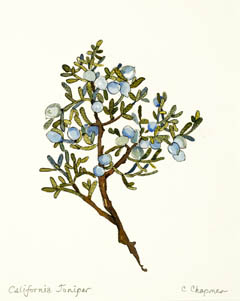
California juniper
guata (Spanish)
mulus, t’pi’ni- (Chumashan languages)
Juniperus californica (Latin)
The Spanish name guata is a loan word from the Luise±o language term waa’at. Camulos, a place in the Piru region of Ventura County, derived its name from the Chumash word for a juniper tree that grew there.
From the wood of the California juniper the Chumash made sinew-backed bows which always retained their shape, no matter how much they were bent. The stave was cut green, allowed to dry, then worked until it was even and smooth. :
The berrylike seed cones of the juniper were ground up into a bright yellow meal called hukhminash, which had a sweet but resinous flavor. Fernando Librado tasted it but had to spit it out-he said there were two Indian foods he could not stomach, whale and mulus. Most of Harrington’s consultants had eaten it, but few had seen it prepared.
California poppy
toroza (Spanish)
qupe (Chumashan)
Eschscholzia californica (Latin)
California poppy figures in Chumash beliefs and myths. According to Fernando Librado, people used to say that poppies were the ruin of girls. Boys would take girls out gathering poppies, and the flowers’ beauty would overcome the girls and cause them to yield to the boys. :
After death, as the soul journeys to Shimilaqsha, the Land of the Dead, it must pass a place where two ravens peck out its eyes. There are many poppies growing there in the canyons on each side. The soul quickly reaches its arms out to each side, picks two of these poppy flowers, and puts one in each eye socket. Thus it is able to see again immediately. When the soul finally gets to Shimilaqsha, it is given eyes of blue abalone.
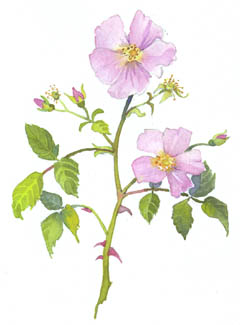
California wild rose
rosa de Castilla (Spanish)
washtiq’oliq’ol, watiq’oniq’on (Chumashan languages)
Rosa californica (Latin)
The Chumash ate the fruit of the wild rose raw. They also pierced the fruits, or rose hips, and strung them for wearing as necklaces and earrings, especially by children.
This plant was regarded as a great remedy for ailments suffered by children. The Chumash used dried, powdered rose petals like talcum to relieve chafing and skin rash in babies. They made the petals into a tea which was administered for stomach pain or colic. In recent decades, Chumash people have used these flowers in a medicinal wash for the eyes and for teething babies.
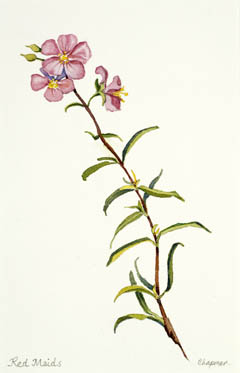
red maids
pil (Spanish)
khutash (Chumashan)
Calandrinia ciliata (Latin)
These spring wildflowers produce quantities of small, shiny black seeds that the Chumash harvested and stored in large baskets in their houses. As needed, people would take out small amounts, and toast and grind them for food. When pounded, the seeds made an oily dough which was easily gathered into balls with the fingers. :
Along with acorns, chia seeds, and islay kernels, pil was one of the most expensive foods in Chumash culture. All these were sought after in trade and were measured in the standard unit of volume, the woman’s basketry hat. Island Chumash people reportedly came to the mainland to buy hatfuls of these seeds, as much as they could carry.
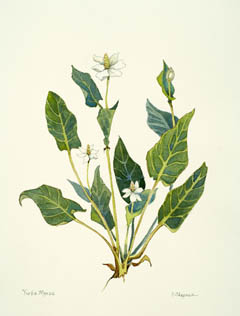
yerba mansa
yerba del manso (Spanish)
‘onchochi, ch’elhe’ tsqono, ‘onchoshi (Chumashan languages)
Anemopsis californica (Latin)
This important medicinal plant was used both internally and externally. Several early writers noted that yerba mansa root tea was valued as a healing wash for cuts, ulcerated sores, and venereal disease, as a blood purifier, and as a wash or poultice for rheumatism.
Yerba mansa was also used to ritually purify and prepare a person who would be carrying ‘ayip, a poisonous, supernaturally powerful substance made from alum and rattlesnake. In preparation, the person fasted and abstained from sex for eight days, during which time he drank yerba mansa tea and washed his face, eyes, and ears with it. For three days before handling the ‘ayip, he cleaned yerba mansa roots, chewed them up and swallowed them, and also inhaled the juice squeezed from the smashed roots from a small white clamshell. He was then considered protected from the dangers of working with ‘ayip.
mugwort
estafiate or yerba ceniza (Spanish)
molush, qloqol, tpinusmu’, moli-sh (Chumashan languages)
Artemisia douglasiana (Latin)
Chumash doctors practiced a technique called ‘apin, or cauterizing, which was regarded as one of the most important remedies available. To perform this treatment, they rubbed dry mugwort leaves between the palms to removes the leaves’ chaffy skin and leave the fine, woolly hairs. They then pressed this “wool” tightly with a twisting motion, using the fingers of one hand against the palm of the other, to form it into a cone shape. : the doctor applied one or several cones to the affected area, an inch or two apart, and lighted them all at the top simultaneously. The cones burned slowly and evenly with an aromatic smoke : The treatment left shiny scars about the size of a dime on the skin, and old people often had many of them on their legs and other parts of their body.
This was the preferred remedy for wounds, skin lesions, and rheumatism because, as Mar-a Solares said, “it kills your infirmity, your ache.”
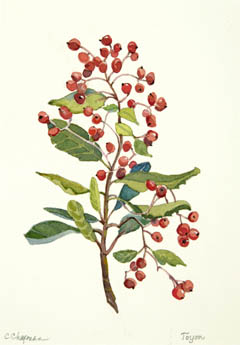
toyon (English and Spanish)
qwe’, ch’okoko, chmishi-(Chumashan languages)
Heteromeles arbutifolia (Latin)
Toyon fruit was a traditional food that the Chumash continued to use well into historic times. The Indians at the Santa Barbara Mission used to go up into the canyon above the mission and collect toyon fruit, which they brought back in cloth sacks. The net bags used in gathering acorns and islay were too coarse for these small berries.
The Chumash said that raw toyon fruit tends to stick in the throat. They sampled it for sweetness as they picked and often did the first step in preparing it right where they gathered it. Most commonly, they toasted the fresh toyon berries in steatite olla over hot coals, stirring frequently. This did not take very long, just until the berries were good and hot. : The fruit was placed in an old water basket or some other vessel and allowed to stand “until it was good and ready.” : After that, the toyon fruit was soft and sweet and could be eaten without any further preparation “as one would eat beans or bread,” sometimes along with toasted, ground chia.
Indian tobacco
pespibata, tabaco (Spanish)
show, stu’yi’ (Chumashan languages)
Nicotiana attenuata, N. clevelandii, N. quadrivalvis (Latin)
Important Note: All species of Nicotiana are toxic.
Tobacco was the only recreational drug used by the Chumash :
To prepare the tobacco mixture, several mussel shells were placed in a fired and fanned with a basketry tray. : After they had turned first red, then entirely white from the heat, the shells were removed with a stick and powdered in a small stone mortar. A small amount of dry tobacco was then added and the combination pounded again, mixing in a little water. The resulting pespibata was molded with the hands into cakes of various shapes and bluish gray in color because they contained so much ash. :
The pespibata mixture was often consumed as a drink. : Tobacco drinking was done especially in the late afternoon before supper, which was the main meal of the day. After drinking the liquid, one went outside, induced vomiting by gagging with the fingers, and returned feeling light and refreshed, with a good appetite for supper.
4•1•1
• Tuesday, September 4, 5-7 p.m.: Free book-signing and reception with Jan Timbrook and Chris Chapman. S.B. Museum of Natural History’s Fleischmann Auditorium. RSVP (required) at 682-4711 x110.
• Thursday, October 4, 7:30 p.m.: Timbrook will give a lecture at the museum’s Fleischmann Auditorium. See sbnature.org/tickets.
• Saturday, October 6, 9 a.m.-2 p.m.: Timbrook will lead a fieldtrip in the Santa Ynez Valley for 20 people. Call 682-4711 x170.
• Wednesday, October 10, 7 p.m.: Timbrook will give a special presentation for museum members at the “Naturalist” level. Call 682-4711 x114 to become a member.



